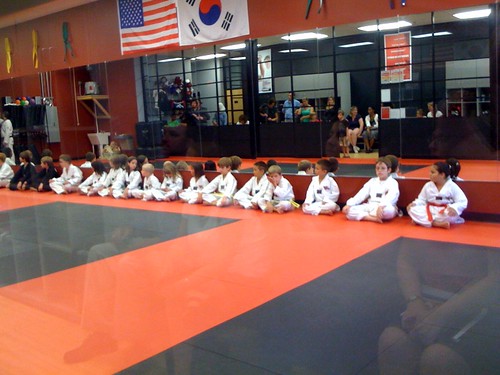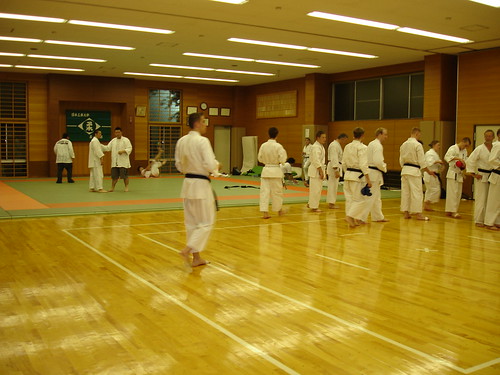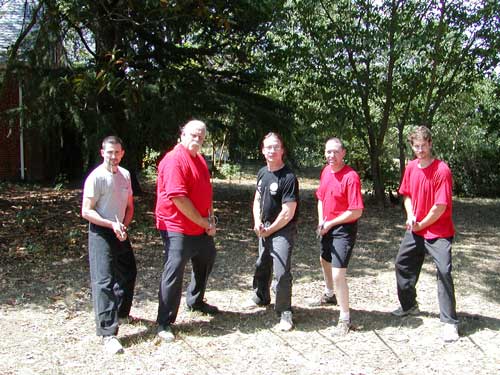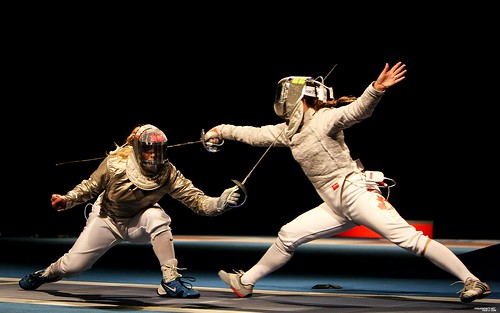Choosing Where to Train
Now that you have some sense of the different martial arts styles and which ones interest you, the next decision is selecting a training location. Whether you choose a sport art or a historical martial art, the key is to find an instructor and dojo/salle/school with integrity, experience, skill, and good instruction. Some dojos/salles/schools or instructors will claim that their method is “the most authentic” or “the most effective”. Since there is no “most effective” or “most authentic” martial arts style, I would avoid paying attention to such marketing hype. Instead, focus your attention on which schools have effective instructors who are good at teaching the techniques for the style of martial art you are interested in learning. In the end, it is up to you, the martial arts student, to determine the true value of the instruction you receive.
Make a List of Candidate Schools
These days, finding nearby martial arts schools is very easy. Your first goal is to make a list of candidate schools in your area that teach the martial art you are interested in. As a first pass at generating this list of schools, simply go to your favorite internet search engine, e.g. Google, and enter a search term like “martial arts” followed by the name of your city, and you should get a good list of schools to start from. Some of these schools might teach the art you want, while others do not. To find out, go to the school’s website and look for information there on the styles they train in.
You can also try other search term combinations, such as substituting the name of your art instead of “martial arts” in the above example.
Note that if a school’s website it out-of-date or poorly constructed, don’t be put off too much. Right now you are just trying to compile a list of candidate schools–you’ll narrow down your list in the next step. Martial arts instructors are not necessarily technical people and the quality of the website is not necessarily a good indicator of their teaching ability.
Depending on the size of your city and the popularity of your martial art in that area, you may or may not have a lot of schools to choose from. But go to the websites of the schools you’ve found and take a look to see what they have to say. While a good school may have no website at all, or may have limited content on their webpages, many schools do have professional websites with good content. So, take a little time to see what the website says about training philosophy, martial arts styles taught, schedules, instructors, prices, and location.
Visit Each School on Your List
Once you have compiled your list, the second step is to visit each school on your list of candidate schools. Martial arts training requires a lot of personal interactions with the teacher and with other students, so it is critical to visit the school, speak with the instructors, and interact with the other students. Once there, you can see the quality of the training location and facilities, and you can get a feel for the personality of the instructor. You should also ask to watch a class, so that you can see the intructor and students in an actual training atmosphere. Some schools may allow you to participate in a free class, so you should definitely take advantage of that option if possible. That way, before you sign a contract to train at the facility, you will be able to assess whether or not you will enjoy training there.
Here are some points to think about or to ask when you visit a school:
-
“How long has the school been in business?” The length of time a school has been in business is one indicator of the success of a school. A new school is not necessarily one to avoid–they may be hungry for new students. But ask around within your community to try to determine the reputation of the school. Unfortunately, some schools seem out just to earn money at the expense of quality instruction. These types of schools earn the reputation of being a “McDojo”, so watch out for them.
-
“How many instructors teach at the school?” Meet them and talk to them. A good school has a head instructor who is in-shape and knows his art, plus there will likely be several more junior instructors who are actively teaching and actively training. 100 students and 1 instructor is a bad student-to-teacher ratio.
-
“Can you watch a class?” If the answer is no, go somewhere else. Not being able to even see a class before signing up for lessons is one indicator of a McDojo (see above).
-
Once you watch the class, “How do the students treat each other and the instructor?” You need to be comfortable with their interactions and be able to imagine yourself participating with them.
-
“Can you take a free lesson?” If not, consider going somewhere else.
-
If you take the lesson, “How much attention did you receive?” “Did you enjoy the training?” You will likely be spending a lot of money and time at your school, so make sure you enjoy it and are learning something.
-
“What do you need to wear to lessons?” Be sure you understand what type of uniform or type of clothing is required to train there, before you start training.
-
“What equipment or other items do you need to purchase?” Again, it is good to know what expenses there will be, beyond your training dues.
- “How much will training cost?” Rates range considerably based on location, instructor, and the art. A good rule of thumb is to make sure you can commit monetarily to six months of whatever they charge before you start training. Some schools have a per-month plan, some a six-month plan, some a year-long contract, and some a per-workout fee.
- “Are the students expected to compete in tournaments?” Some schools pressure their students to compete in martial arts tournaments. If you do not want to compete, then such expectations are good to know upfront.
- “How long does it generally take to achieve black belt?” Different schools and arts have different progression speeds through the level ranks. If getting to black belt rank is your goal, then you should know upfront about how long it takes the average student to get there. Of course this depends on the student going to class!
- “How much are testing fees?” Most schools are organized into colored belts or sashes or levels to track your progress in learning the material. To advance from one level to the next most often requires a performance test where you are evaluated on the material. How much are the testing fees? Some schools charge a flat fee, no matter the level, while other schools charge more the higher the level of the test.

Evaluate the Information You have Gathered
Now, after you have visited the schools on your list and have compiled the information from asking the above questions, you should have enough information to make a decision on where to train. Generally one school, based on the information you have compiled, will rise above the others. If two schools seem equally good places to train, then ask yourself which school you could see yourself attending for three years? You should want to go to the school you select, since going to class is the whole point signing up for martial arts lessons and you don’t want any reason to keep you from going. So if one of the two good schools is closer, or maybe you are friends with someone at the school, or maybe there is some reason you may be happier at one school than the other, then that school is probably the better choice, since it suggests you will be more likely to attend for the long term.
Other Places to Train
What do you do if there are no schools of interest in your city? Expand your search to nearby cities using the above procedure and consider traveling to train. Also, consider searching nearby universities, your local YMCA, or other gymnasiums. Sometimes these places will offer martial arts courses you can enroll in.
Another option: look for martial arts clubs that may be in your area. Not all martial arts are taught in big gyms and schools. Martial arts clubs are loosely organized collections of martial artists who gather together to train for the love of the art, and the membership fees may be much less than with a large martial arts school. Sometimes these clubs meet to train in local parks or at the nearby university.
Decisions, Decisions, Decisions
Deciding which martial art interests you most and where you want to train can be fun, since you can do a lot of research online, visit different schools, read interesting books about the various styles, and watch lots of martial arts movies or even martial arts demonstrations that might take place at nearby festivals. In part 4 of this series I list several resources that you may find useful in your research, along with some final thoughts.
This is part 3 of a four-part series on how to get started in martial arts:
- How to Get Started in the Martial Arts, Part 1: Benefits of Martial Arts
- How to Get Started in the Martial Arts, Part 2: Choosing a Martial Art
- How to Get Started in the Martial Arts, Part 3: Choosing a Place to Train
- How to Get Started in the Martial Arts, Part 4: Final Thoughts
Feedback
I hope you enjoyed this post. If so, please consider shopping for yourself using this link to Amazon.com. Thanks!
For those who’ve done martial arts before, what did I miss? For those considering martial arts training, what else would you like to know? Please, send feedback my way— I’d love to hear from you.




